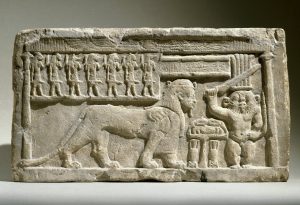Stela with Bes and Tutu
In this limestone stela, two deities are present; which like we talked about is shown in the hierarchical size. The two deities are a big portion of this stela showing the significance of power Gods have in ancient Egyptian society. On the left corner are seven small figures that similar to Tutu and Bes are animal and man alike. These small figures are the seven demons that Tutu controls. Also, there is a form of hierarchy in this work, making these seven demons enclosed in a box with clear lines that divide them for Tutu and Bes. These lines also navigate the eye towards these two deities. It is also important to note that both Gods are depicted as animals. Animals that are powerful, not donkey’s or mice, but half man half lion (sphinx) with a snakehead’s tail (Tutu) and another half bull half man (Bes). Bes is shown holding a sword, which can be a symbol of warfare and fighting, which is representative of what he is a God of. These pieces were intended to appease the deities to be less hostile and aggressive. In fact, this piece, in particular, was intended for the temple as a sign of gratitude and protection. Similar to what we have learned in this units appeasing these aggressive Gods was a religious aspect of Egyptian life, it was necessary in order to live moral and fearless lives.

Fairbanks or Garvey by John T. Riddle
The reason I chose this piece is because of the obvious division between choosing a destiny or resigning to one already decided, specifically for the African American culture in the United States of America. On one spectrum, (the left part of this piece) you have what looks like a brand of detergent for clothes in the form of powder. The phrase on the bottom of “Gold Dust” states in Spanish, “WARNING POWDER: Powder to clean.” The use of dividing this artwork into two allows for the emphasis to be on both messages. In the center of the right, we have a man in a marching band outfit who unlike the two boys on the left, looks empowered. He is dressed lavishly and not just defined but his color of skin unlike the two young boys on the left. Also, this piece states, “Up you mighty race,” with a message on the bottom, “What will you accomplish.” Opposed to the left part of this piece this message empowers and embraces, rather than stereotypes a race.
I think this united the exhibition, showing not only the history of what was expected onto this culture; but also shows the empowerment of each individual allowing them to change the destiny placed onto them in this nation. The exhibition had historical pieces and individual pieces of cultural pride, which in turn was embodied perfectly by this piece (in my opinion).


